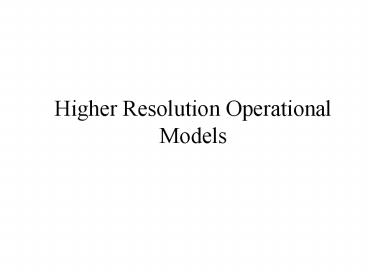Higher Resolution Operational Models - PowerPoint PPT Presentation
Title:
Higher Resolution Operational Models
Description:
... 4/Day = 6 hr update Forecasts to 84 hours 12 km horizontal grid spacing New NAM NEMS based NMMB B-grid replaces E-grid Parent remains 12 km to 84 hr Four ... – PowerPoint PPT presentation
Number of Views:39
Avg rating:3.0/5.0
Title: Higher Resolution Operational Models
1
Higher Resolution Operational Models
2
Operational Mesoscale Model History
- Early LFM, NGM (history)
- Eta (mainly history)
- MM5 Still used by some, but phasing out
- NMM- Main NWS mesoscale model. Sometimes called
WRF-NMM - WRF-ARW Heavily used by research and some
operational communities. - The NWS calls their mesoscale run NAM North
American Mesoscale . Now NMM
3
Eta Model
4
Ptop
? 0
Eta Coordinate And Step Mountains
? 1
MSL
5
(No Transcript)
6
Horizontal resolution of 12 km
12-km terrain
7
Drawbacks of the Eta Coordinate
- The failure to generate downslope wind storms in
regions of complex terrain - Weak boundary layer winds over elevated terrain
when compared to observations - The displacement of precipitation maxima too far
toward the bottom of steeply sloping terrain as
opposed to the observed location near the top
half of the terrain slope - The reduction in the number of vertical layers
used to define the model atmosphere above
elevated topography particularly within the
boundary layer
8
(No Transcript)
9
WRF and NMM
10
Why WRF?
- An attempt to create a national mesoscale
prediction system to be used by both operational
and research communities. - A new, state-of-the-art model that has good
conservation characteristics (e.g., conservation
of mass) and good numerics (so not too much
numerical diffusion) - A model that could parallelize well on many
processors and easy to modify. - Plug-compatible physics to foster improvements in
model physics. - Designed for grid spacings of 1-10 km
11
WRF Modeling System
12
Two WRF Cores
- ARW (Advanced Research WRF)
- developed at NCAR
- Non-hydrostatic Numerical Model (NMM) Core
developed at NCEP - Both work under the WRF IO Infrastructure
NMM
ARW
13
The NCAR ARW Core Model (See www.wrf-model.org)
- Terrain following vertical coordinate
- two-way nesting, any ratio
- Conserves mass, entropy and scalars using up to
6th order spatial differencing equ for fluxes.
Very good numerics, less implicit smoothing in
numerics. - NCAR physics package (converted from MM5 and
Eta), NOAH unified land-surface model, NCEP
physics adapted too
14
The NCEP Nonhydrostatic Mesoscale Model NMM
(Janjic et al. 2001), NWS WRF
- Hybrid sigma?pressure vertical coord.
- 31 nesting ratio
- Conserves kinetic energy, enstrophy and momentum
using 2nd order differencing equation - Modified Eta physics, Noah unified land-surface
model, NCAR physics adapted too
15
- The National Weather Service dropped Eta in 2006
as the NAM (North American Mesoscale) run and
replaced it with WRF NMM. - The Air Force uses WRF ARW.
- Most universities use WRF ARW
16
NWS NMMThe NAM RUN
- Run every six hours over N. American and adjacent
ocean - Run to 84 hours at 12-km grid spacing.
- Uses the Grid-Point Statistical Interpolation
(GSI) data assimilation system (3DVAR) - Start with GDAS (GFS analysis) as initial first
guess at t-12 hour (the start of the analysis
cycle) - Runs an intermittent data assimilation cycle
every three hours until the initialization time.
17
October 2011 Update NMMB
- One-way nested forecasts computed concurrently
with the 12-km NMM-B parent run for - CONUS (4 km to 60 hours)
- Alaska (6 km to 60 hours)
- Hawaii (3 km to 60 hours)
- Puerto Rico (3 km to 60 hours)
- For fire weather, moveable 1.33-km CONUS and
1.5-km Alaska nests are also run concurrently (to
36 hours). - A change in horizontal grid from Arakawa-E to
Arakawa-B grid, which speeds up computations
without degrading the forecast
18
September 2011 NAM Upgrade
- New NAM
- NEMS based NMMB
- B-grid replaces E-grid
- Parent remains 12 km to 84 hr
- Four Fixed Nests Run to 60 hr
- 4 km CONUS nest
- 6 km Alaska nest
- 3 km HI PR nests
- Single placeable 1.33km or 1.5 km
FireWeather/IMET/DHS run to 36hr
- Current NAM
- WRF-NMM (E-grid)
- 4/Day 6 hr update
- Forecasts to 84 hours
- 12 km horizontal grid spacing
19
NMMB 4-km Conus
20
NMM
- Was generally inferior to GFS
21
(No Transcript)
22
Looks like it has improved
23
(No Transcript)































